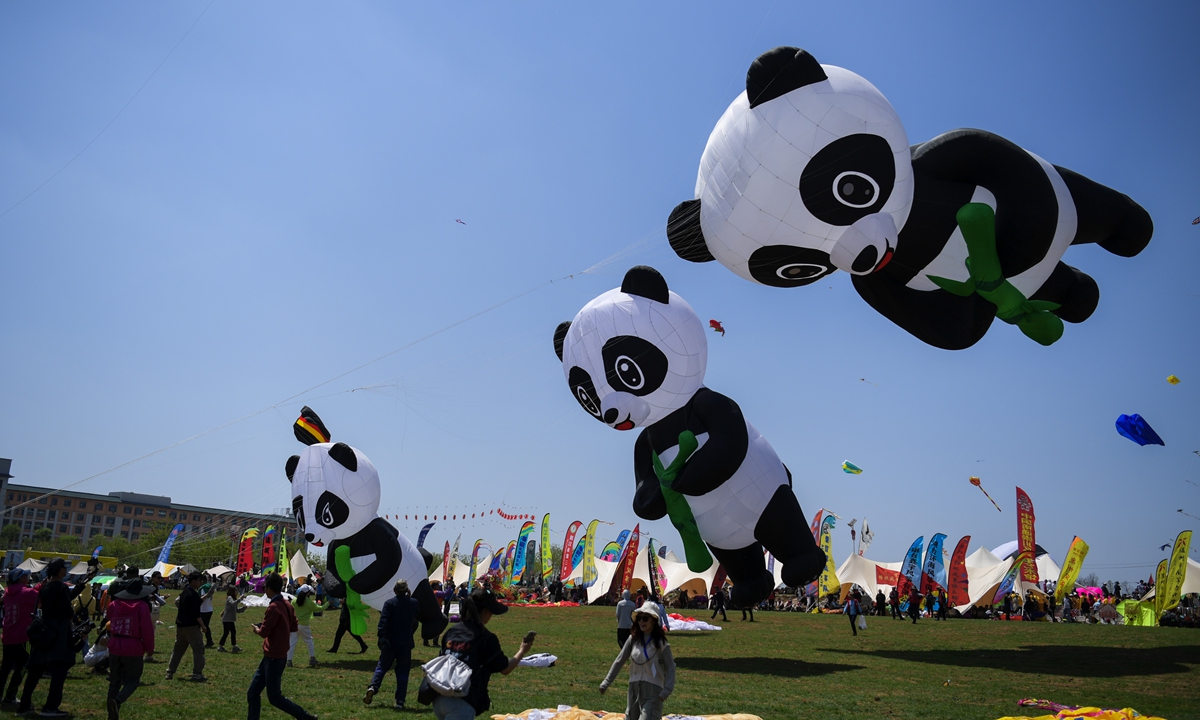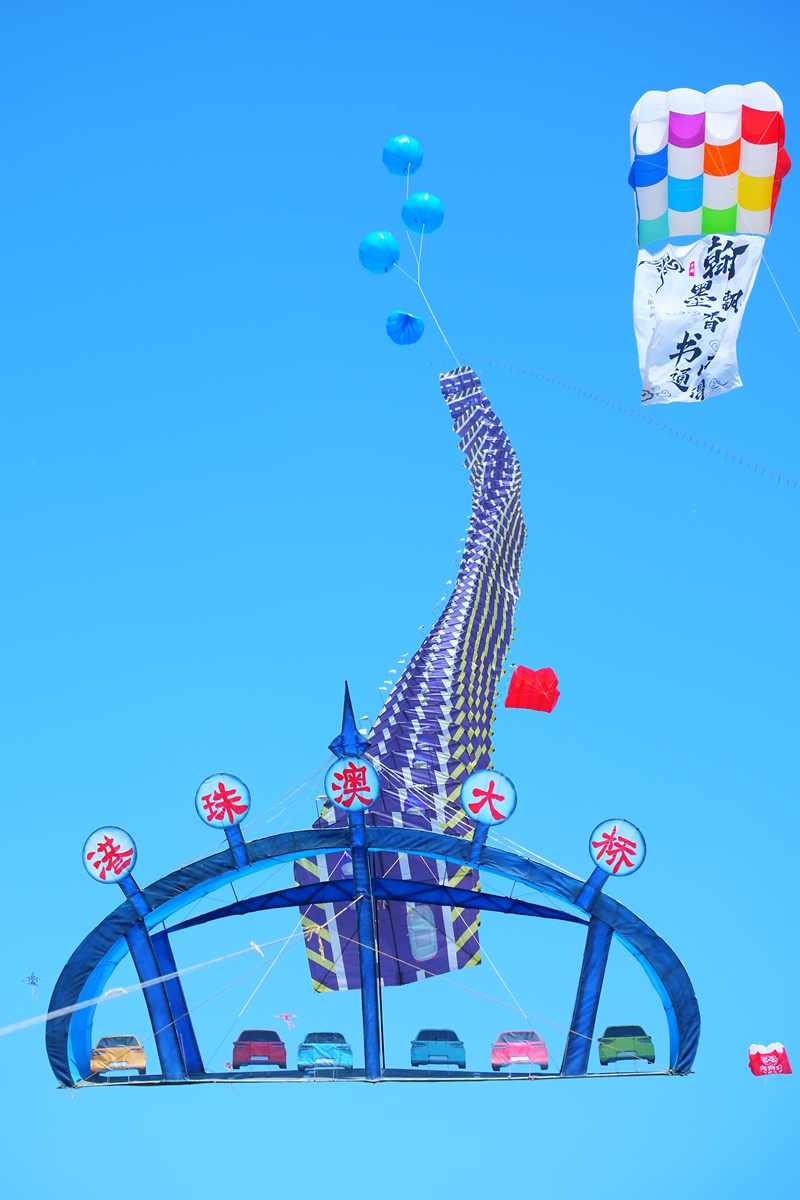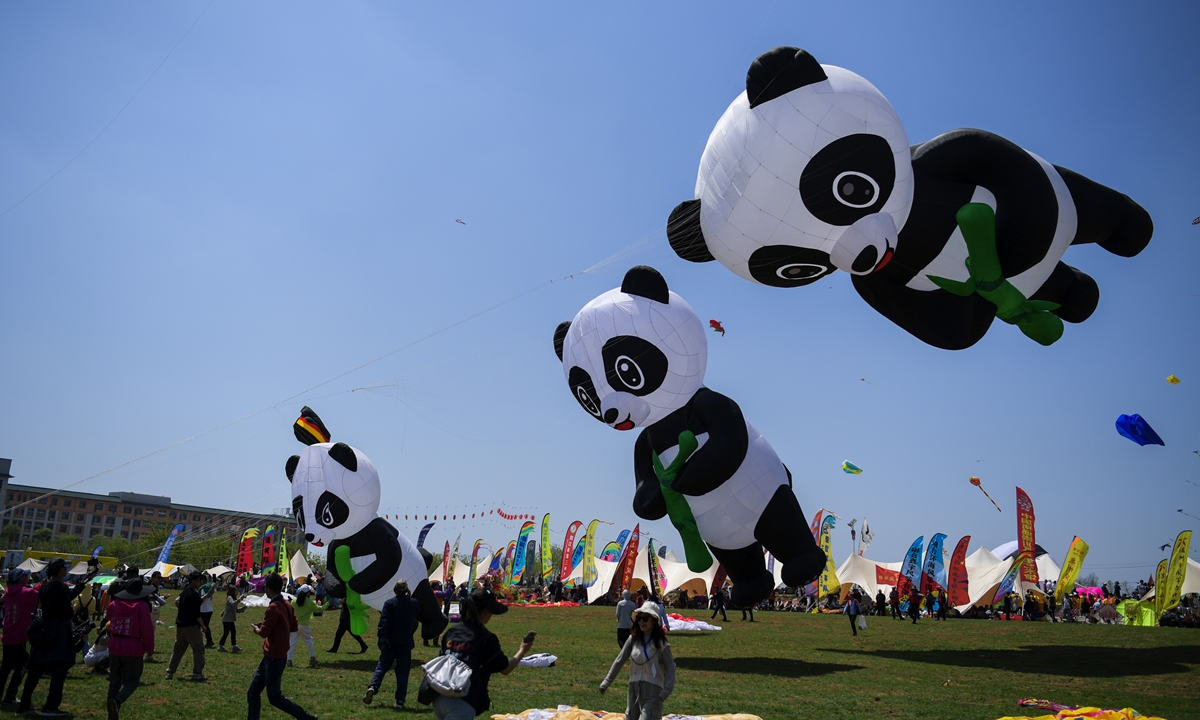
People fly kites at the Weifang International Kite Festival in Weifang, Shandong Province, on April 20, 2024. Photo: VCG
The 41st Weifang International Kite Festival and the 2024 Weifang Kite Carnival were just concluded in Weifang, East China’s Shandong Province, drawing nearly 460 participants from 46 countries and regions. This event allows people from China and abroad a closer look at the inheritance and invigoration of the kite as a cultural symbol in the “kite capital of the world.”
It’s widely acknowledged that the kite was first invented in China about 2,300 years ago. The philosopher Mo Di, also known as Mozi, devoted years to crafting a “wooden bird,” an early prototype capable of flight for one day. Later, Lu Ban, who is revered as a deity among Chinese craftsmen, improved upon the design by substituting wood for bamboo, creating a “bamboo bird” that could stay airborne for up to three days.
After thousands of years of evolution through military usage and as an object of leisure and entertainment, the kite gradually transformed into a cultural symbol in China. Kites flying high embody Chinese people’s yearning for the sky and good wishes for life. This transformation has also allowed for a diversification in kite styles, manufacturing techniques, and decorations, leading to the rich variety of kites seen today.
Family heirloom
At his home workshop in Wangjiazhuangzi village, Weifang, Wang Xingsheng, an inheritor of Weifang kite art, a national-level intangible cultural heritage, uses one hand to hold a knife and the other to pinch the bottom of the bamboo piece, making the skeleton of a dragon-headed centipede kite, one of the most celebrated Weifang kite designs produced through complicated craftsmanship. The dragon head usually combines the features of tiger and lion heads, and is made up of more than 150 bamboo strips and about 500 buckles.
Wang’s table is laden with sketches, alcohol lamps, bamboo pieces, tweezers, and materials such as cloth. Meanwhile, sitting back-to-back, his 23-year-old daughter tests out a ball-shaped structure by comparing it to short videos on her phone.
“My family has been doing this since I was a child. The skills, the dedication, the sense of fulfillment by making art and transforming wild imagination into reality while making a living, were just all natural to me. I met my wife, the love of my life, through kite-making. And now my daughter is carrying on the heritage,” said Wang while collaborating with his wife to assemble the pieces.

A kite in the shape of the Hong Kong-Zhuhai-Macao Bridge flies in the air at the Weifang International Kite Festival in Weifang, Shandong Province, on April 20, 2024. Photo: Courtesy of organizers
The rolling lamp, a traditional folk acrobatic practice with a history spanning more than 800 years in Yuhang, Zhejiang Province in East China, has been designated as a piece of national intangible cultural heritage. This ancient art involves a cleverly designed prop consisting of two bamboo spheres – a larger external one and a smaller internal one. The inner ball, which houses a lit candle, is mounted on a rotating ring, allowing it to remain upright no matter how the outer ball is rolled. This ensures the candle stays horizontal, showcasing a blend of strength, skill, agility and finesse.
Wang’s daughter Wang Jiaxin first saw the prop on social media and was intrigued. Curious, she decided to combine these two heritages together. “Kites seem to be engraved in my DNA, and I am thrilled to continue my father’s craft and bring new vitality it.”
“I dare to imagine and try anything, focusing more on creativity and fun. But on the craftsmanship and techniques’ side, it definitely will benefit me a lot to learn from the older generations like my father. I hope young people will learn more about intangible cultural heritages as a whole, not just about kites. The rich historical and cultural heritage of China over the last 5,000 years truly deserves young people’s cultural confidence,” she said.
Revitalizing tradition
In recent years, Weifang kite artisans have innovated on the basis of traditional kite-making techniques, and the kite industry has grown larger. Wang Licai, manager of Sanli Kite Factory in Wangjiazhuangzi, told the Global Times, “The modern kites we produced, with simple shapes and rich patterns, are well-liked by customers from all over the country and many foreign customers, generating a significant income for local residents.”
Wangjiazhuangzi’s kite industry, while absorbing the essence of traditional kite-making, has now integrated continuously innovative technologies such as 3D digital printing and laser cutting. In recent years, the village has actively encouraged kite production enterprises to use environmentally friendly materials.
Currently, there are nearly 100 kite manufacturing and processing enterprises in Wangjiazhuangzi, and more than 200 e-commerce businesses, with employees making up half of the village’s total population and providing employment for nearly 10,000 people in surrounding areas. The annual production of kites accounts for about 80 percent of Weifang’s total, and the kites are exported to many countries, introduced Wang Zhenhua, a village official.
The village’s thriving kite industry has now attracted more and more young people to return home, who are the main force of pioneers in e-commerce and livestreaming, he added.
In 2023, the village established the Weifang Modern Kite Cooperative, which not only aids in the industrial development of kites as a local cultural product but also strengthens the protection of its intellectual property rights.
The first floor of the cooperative serves as a Kite Culture Museum. The second floor houses an Intangible Heritage Experience Hall, where visitors can enjoy the fun of making kites by hand. The cooperative has hosted international students in China, as well as business groups and tourists from countries like South Korea and Germany.
“Previously, we held a cultural exchange event to welcome a group of college students from the island of Taiwan. These kites had one wing painted by students from Taiwan and the other painted by students from Weifang. They carry our shared dreams and best wishes,” said Wang.
The village also plans to launch a “Kite Culture Tour,” to promote the history, culture, and industry of local kites, aiming to create a study base for middle and high school students, Wang added.
